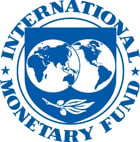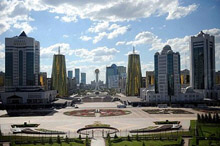
Typical street scene in Santa Ana, El Salvador. (Photo: iStock)
IMF Survey: Kazakhstan: Making the Most of Its Oil Wealth
August 16, 2011
- The oil sector has lifted growth and improved well-being
- But oil activity has only limited spillovers on other economic sectors
- Diversification can help buffer against oil shocks, spur job creation
Oil plays a big role in Kazakhstan. With nearly 40 billion barrels in reserves and 2 percent of global production, the country has the world’s ninth largest proven reserves and is among the 20 largest oil producers.

Skyline of Astana: In Kazakhstan, oil revenues can finance greater investment in health, education, and infrastructure (photo: Sadat/XinHua/Corbis)
NATURAL RESOURCE MANAGEMENT
In 2010, the oil sector accounted for more than 11 percent of GDP, and oil exports represented nearly 57 percent of total exports of goods and services.
With major new discoveries in recent years and the development, notably, of the Kashagan oil field in the northern part of the Caspian Sea, oil will continue to attract major investments and act as a main driver of the country’s growth. Kazakhstan, located in Central Asia, is the world’s largest landlocked country.
A new IMF study finds that a key challenge for the government is to ensure that the benefits from oil wealth are shared by the population as a whole. In an interview, Ana Lucia Coronel (IMF Mission Chief for Kazakhstan) and Narayanan Raman (Economist in the IMF’s Strategy, Policy, and Review Department) spoke about what oil wealth means for Kazakhstan’s development.
IMF Survey online: How is Kazakhstan managing its oil wealth?
Coronel: Prudently. Part of the oil proceeds contribute to financing development needs, while another significant part is saved for the benefit of future generations and to help insulate the economy from swings in inflows generated by global oil price fluctuations. Kazakhstan’s stabilization fund—the National Fund of the Republic of Kazakhstan—is the cornerstone to managing and preserving the country’s oil wealth. The central bank manages the fund, using it to save the bulk of oil-related fiscal revenues. The government budget is allocated a fixed annual transfer of $8 billion from the fund. Because of the authorities’ discipline in adhering to this target, and thanks to high oil prices, the fund has increased from about $20 billion in mid-2009 to over $38.7 billion in July 2011.
IMF Survey online: What challenges does the country’s dependence on oil pose?
Raman: As with other oil exporters, the volatility of oil prices presents challenges. The government depends on oil for the largest part of its revenues. For instance, in 2010, almost one half of government revenues came from extraction and exports of oil. Thus, when oil prices fall, the lack of other sources of revenue may constrain fiscal spending. Lower prices could also hinder exploration and development of new wells, especially in the new Kashagan oilfield, where the bulk of proven oil reserves is located. But Kazakhstan’s prudent policy of saving the lion’s share of the oil proceeds in the oil fund lessens these risks.
Another challenge is that the oil sector is not a main source of job opportunities, given that the sector is more capital- than labor-intensive. Consequently, even a significant expansion of the sector is unlikely to lead to a corresponding increase in job creation.
The unique features of Kazakhstan’s oil industry also pose some risks. Conditions off the shore of the Caspian Sea, where the bulk of the reserves is located, are challenging. The weather can be extreme. Geological conditions can also affect the accessibility (highly pressurized wells can make drilling difficult) and the quality of production (the presence of sediment can lead to impurities in the oil). Volatility in oil prices could therefore lead to planned investment being delayed.
IMF Survey online: What sorts of spillovers are there from oil sector activity onto other sectors of the economy?
Coronel: Although the link between the oil and non-oil sectors seems to have become stronger in recent years, the direct benefits of increased oil activity are only shared by a few related sectors, such as transportation and communications. Other key domestic drivers of growth—including manufacturing, construction, real estate, and various other services—do not appear to benefit directly from oil sector activity. In particular, given the pattern of financing in the oil sector—where companies generally bring their own funds into the country for investment—there is a limited role for the domestic financial system.
In addition, oil-related outflows through the balance of payments are quite large. These include imports of capital equipment needed to develop oil fields, income repatriated to foreign investors (which amounted to nearly 30 percent of oil exports in 2010), and repayment of loans from parent companies of foreign direct investors. Of course, to some extent, these outflows are the natural consequence of the heavy participation of foreign investors in the oil sector, which in turn enhances the levels of Kazakhstan’s capital stock and potential growth.
Outflows from the overseas investments of Kazakhstan’s stabilization fund are also quite substantial. These outflows accounted for about one third of gross outflows in the financial account of the balance of payments in 2010. The savings held abroad allow the authorities to guard against volatility due to oil price fluctuations and capital flows, but also reflect the lack of opportunities to invest more funds domestically due to a still-shallow financial system.
IMF Survey online: What options does Kazakhstan have to diversify away from oil?
Raman: Other than industries related to the sector like transportation and communication, the experience of other resource-rich countries points to the chemicals sector as an area of comparative advantage. Improving the business and investment climate to facilitate private sector activity in this sector—as well as others—would help spur development.
Kazakhstan has made significant progress on this front. According to the World Bank’s 2011 Doing Business rankings, Kazakhstan rose by an impressive 15 places during the year—the fastest improvement in the region. Kazakhstan scores well in terms of registering property (28th) and has significantly improved in the ease of starting a business (from 85th in 2010 to 47th in 2011). Other surveys point to strengths in public finance, infrastructure, and labor market flexibility.
But a number of areas for improvement stand out. In terms of trading across borders, the World Bank’s Doing Business index ranks Kazakhstan close to the bottom 1 percent of countries surveyed. This can be attributed only partly to the fact that the country is landlocked. Kazakhstan also slipped by three places for access to credit, partly due to the ongoing problems in the financial sector. And, despite a per capita income of over $8,800, Kazakhstan lags in health and education indicators, reflecting its relatively low spending in these areas.
Coronel: Ultimately, private investment, including foreign investment, is the key to achieving high-quality growth, and the authorities plan to develop a multifaceted reform agenda to achieve this. In addition, while the rules governing activities in the oil sector can be expected to evolve, the authorities should take care to safeguard the predictability of the investment regime, thereby preserving investors’ capacity to plan.
IMF Survey online: How can the Kazakhstani government use the country’s oil wealth to further catalyze development?
Coronel: The authorities have done a good job of managing the oil revenue and have brought major improvements in economic development and the population’s well-being. We agree that the authorities should maintain the current policy of saving the bulk of the revenue. Looking forward, more flexibility in the rules that govern the stabilization fund, with the purpose of linking the transfers to the budget with well-defined medium-term fiscal targets, would help to better use oil revenues to finance investments in health, education, and infrastructure. This public investment strategy should be complemented by continued private sector investment in the oil industry sustained by market-friendly conditions.


